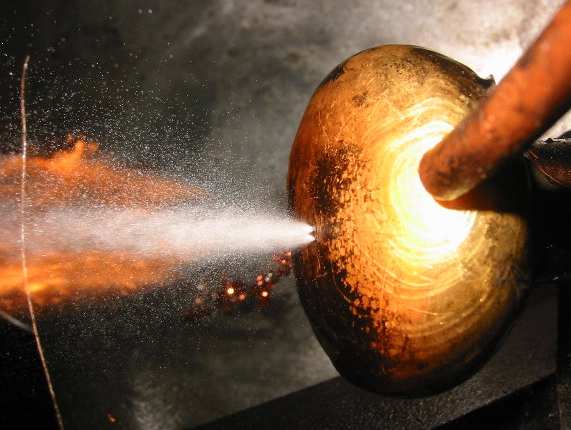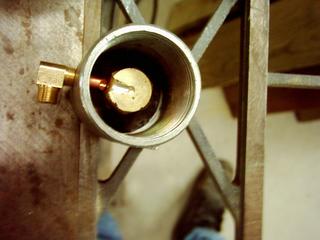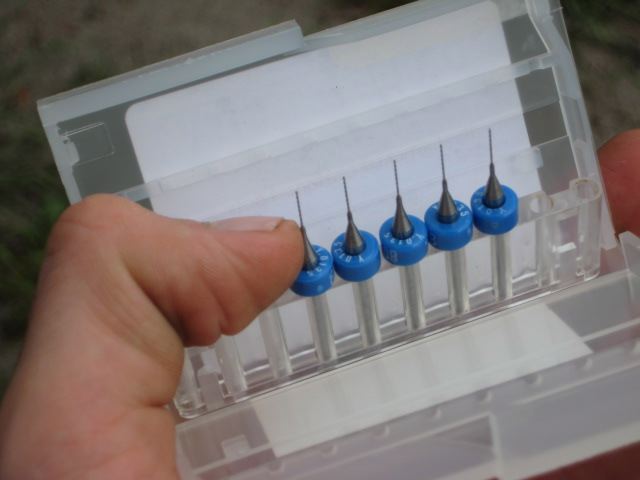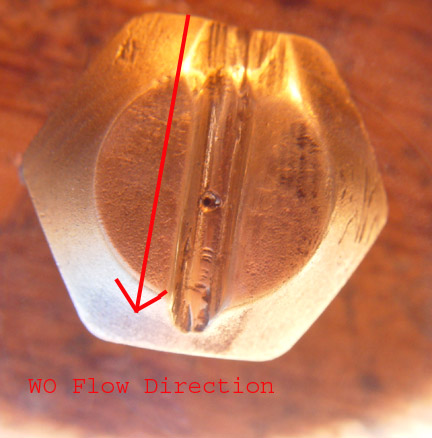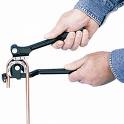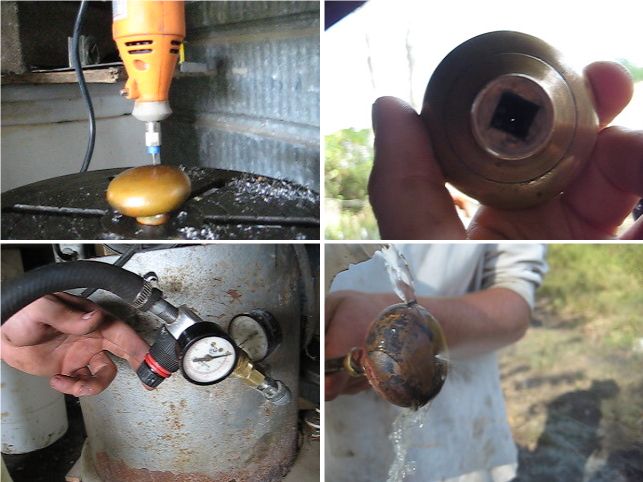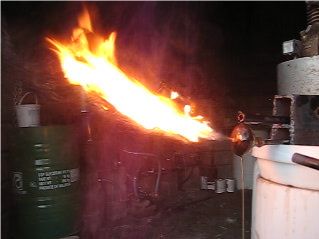Babington Burner
Basics
- Babington Burners are Liquid Fuel burners that utilize the Babington Atomization Principle
- It uses a flowing film of the liquid flowing over a ball with a hole which air is blown through at modest pressures
- Thus only a BASIC liquid pump, and cheap air pump are needed
- No high pressure solenoids or valves are needed either
- Thus it should be far less critical to control Fuel Cleanliness etc
- The manufacturer ( Airtronics ) claims finer atomization than conventional high pressure Spray Nozzles used in Home Heating Oil / Diesel Heaters etc
- Although citation needed, especially vs Dual Fluid Spray Nozzles / Rocket Fuel Injectors or even Rotary Cone Atomizers / a Blisk that behaves as a RCA
Unknowns
- Impact of Hole Diameter on Atomization
- Impact of Fuel Viscosity on Atomization
- Role of Blower Fan supplied Air on Combustion Process/Blower Efficiency etc
- The Airtronics Design used a Blower Fan as well as dual babington atomizers
- Supposedly an “impactor” ball placed in front of the orifice further reduces particle size aiding in combustion etc
- The Airtronics Design used a Blower Fan as well as dual babington atomizers
- Impact of Fuel Flow Rate on Atomization and Thermal Output
- Impact of Atomizing Air Pressure and Flow Rate on Overall Process
- Especially in terms of Controls Engineering / Model Based Design this is a MAJOR unknown
- Old airtronics footage mentions ~ 15 PSIG air being used
- Especially in terms of Controls Engineering / Model Based Design this is a MAJOR unknown
- Degree of Fuel Agnosticism
- As of now it seems they can handle most “heavy” fuels such as
- Diesel Fuel
- Jet Fuel / Military Fuel like JP-5 JP-8 etc
- Bio-Diesel (ie Transesterification Biodiesel ) and Renewable Diesel
- WVO / WCO
- What isn’t well documented is utilization of more volitile fuels such as
- Fuel Alcohols
- Gasoline
- Lighter Distillates/Fractions such as some Pyrolysis Oil may be
- Furthermore HEAVIER fuels such as
- Crude Oil
- Albeit in the OSE Context this would more likely mean heavier Pyrolysis Oil or HTL Bio-Crude rather than fossil crude oil
- Heavier Fats, Oils, and Grease (Think heated liquid lard/tallow like old school lighthouses, rather than a liquid at stp WVO)
- Crude Oil
- Also HEAVY solid contamination or slurries such as Refinery Slops , UNFILTERED WCO , and Slurry Fuels are also a major unknown
- Corrosive fuels such as High Sulfur Diesel or most Pyrolysis Oil also may require special design considerations
- As of now it seems they can handle most “heavy” fuels such as
- Emissions performance of these burners
- In particular can Staged Combustion / Dry Low-NOx strategies be used
OSE Dev Work
Video of Successful Burner at Factor e Farm
http://www.youtube.com/v/uwO_ysHOJZ8&hl=en&fs=1
OSE Development Use Case Introduction
- This burner is important because it is a versatile source of heat for: space heating, metal melting, glassworks, pottery, steam engines for remote power, heat engines for mobile power in cars and tractors, and many others. We can use it with any waste oil - crankcase, vegetable, etc. - plus Pyrolysis_Oil once we develop it.
Problem Statement
- The problem statement is to design a simple, low-cost, high performance, optimal, open source, and replicable (see OSE Specifications) Babington burner. This burner should:
- Be capable of burning any oil
- Have auto ignition and flame sensor for auto reignition
- Circulating oil pump
- Compact size
- Scalability to larger and smaller power units
There is one Babington burner that has most of these features on the market - from yellowbiodiesel.com - turnkey Babington burner (Broken link)
Background Research - Design Rationale
So what is the synthesis of available information regarding the Babington Burner? Wastewatts is one Yahoo group that deals with the Babington. What is the state of the art for:
- The type of ball used - size, shape (endcap with groove, ball, doorknob). Does wall thickness matter
- Do people have trouble with debris from inside the ball clogging up the ball hole? We had trouble, so we are cleaning our brass doorknow with an overnight vinegar bath.
- What is the number of holes that people have used? I've seen 1 and 2 hole versions on the internet.
- What is the hole size range? I've seen .01-.02 being used.
- What is the pressure range used?
- What is the range of flame size possible for a clean burn?
- Did anyone measure fuel usage rate and heat output in BTU or kW?
- What is the optimal pump used for active fuel pumping?
- Is there an upper limit to the desirable air pressure for the burner ball?
- What is the best type of shroud to use?
- Pipe section - what length, diameter, wall thickness?
- Air holes - what is the number and location for these?
- Ends of pipe - the flame end is open, and burner ball end is closed?
- Does anyone use forced air for additional air input?
- Applications - has anyone field-tested:
- Shop heating? There are lots of youtube videos.
- Water heating with heat exchanger? [Yes http://www.youtube.com/watch?v=jBlZLQcj1IU]
- Steam generation? The last video shows a heat exchanger with water, I bet [this would work the same with a Babington Burner http://www.youtube.com/watch?v=WQ_mBwyTaiM&feature=related].
- Steam engine operation? The previous two ideas would need to be tested first.
- Combined heat power applications?
- Metal melting furnace? [This guy http://www.youtube.com/watch?v=CjDeGDn_fkI] melts an aluminium cylinder head Aluminium.
- Pottery kiln? Simple kiln with Babington Burner [one http://www.youtube.com/watch?v=QUtgDPlSbVY] and [two http://www.youtube.com/watch?v=tvpjeG9wYiU].
- Brickworks? See above videos.
- Glassworks applications? Aluminium has a similar melting point to glass.
- Mobile power application in steam cars and tractors?
- Flame weed killer?
- Flamethrower for parades?
- What measures need to be taken to assure the flame does not go out?
- What is the optimal temperature range for the fuel feed, and how to preheat the fuel?
- What are other issues/quirks that make the Babington unstable?
- What is the expected lifetime of a burner ball? Is this an issue?
- Is regular cleaning required, or can this system be self-cleaning in continuous burning?
- Does anyone have effective, complete system designs that we can replicate?
Internet Research
After searching for hours on details for the Babington burner, here is the best one:
http://www.aipengineering.com/babington/Babington_Oil_Burner_HOWTO.html
Here's a video that shows the clear potential of the Babington:
http://www.youtube.com/watch?v=78ebfypFLXI
Here is several pictures of a design
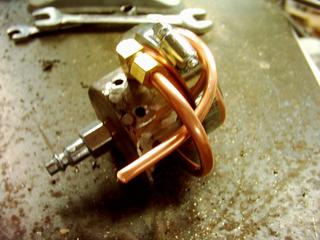 Preheating oil via copper loop before atomization
Preheating oil via copper loop before atomization
Parts Sourcing
Turnkey system
- http://yellowheat.com/catalog $1500 (broken link)
Drill Bits
Burner Balls
http://homebrewpower.co.uk/html-shop-products/babington-burner-nozzles-for-sale.html
Babington Nozzles For Sale Babington burner atomizing nozzles are used to atomize almost all combustible fuel sources. Fuels such as vegetable oil, WVO waste vegetable oil, WMO waste motor oil, waste gearbox oil, waste transmission oil, peanut oil, canola oil and paraffin oil can all be burned very cleanly.
We guarantee to send each individual Nozzle out within 3 working days of receipt of money.
Our Babington Burner Nozzles have the following specifications:
Ball Diameter 50MM Ball Material 1MM Thick Spun Brass Air Connection 15MM Copper Compression Gland Brazing Metal 55% Sure Silver M25T Rods 680 Degrees Celsius Melting Point Atomizing Hole Specification 0.0135" Diameter Hole - Pillar Drilled @ 20,000 RPM Air Pressure Suggested Rating 15 - 80 PSI - Set To Suit Individual Application Finish Acid Dipped, Hand Wired & Polished Notes On Finish Oxidization will occur when exposed to air - This does not affect performance Construction Hand Made In The United Kingdom Babington Ball Usage Clean Atomization of combustible oils & fats - Various Heating Projects Purchase below if you are in the UK Click below for the rest of the world
http://homebrewpower.co.uk/html-shop-products/babington-burner-nozzles-for-sale.html
Burner Ball
Here is a brass endcap with a channel for directing oil flow:
Does this work better than a ball?
Heat Exchanger for Water Heating
We need to coil tubing for a heat exchanger. From Northern Tool:
Implementation at Factor e Farm
On 9.29.08 we started to put together our Babington burner.
We drilled a 0.0135 inch hole in the face of a hollow, brass doorknob - and brazed on a fitting that supplied compressed air at a constant pressure between 20-35 psi. We were able to atomize water but when we tried motor oil we had problems. We were able to produce a bit of a flame but never sustained burning. Two possibilities: 1) the hole became clogged from debris inside the burner ball, 2) the oil was not heated sufficiently. Has anyone had success in sustaining a flame over a long period? What is a good method for automatic ignition? Best way to regulate the flow over the ball? Any feedback is welcome from experienced Babsmen.
Technique: we attached a rotary tool to a regular drill press - to utilize the up-down motion of the drill press with the rototool as the work tool for the .0135 micro drill bit.
Water atomization was successful, seen in the last picture. Fuel atomization was not.
Next steps: heat oil properly - for now on a stove top, and use a metal dispenser container. Clean out the inside of the burner ball.
A day later: success!
May 2009 [ Reply from Richard Rea ] I have experimented with the Babington system. Ball size = 50mm single hole Hole size = .01 in air = 3 bar Fuel = recycled veg Fuel temp = 60 deg C minimum for start Open tube Circ pump = 12v wiper motor coupled to a sump oil pump Speed control= pulse width modulator Burn rate = estimate 30,000 BTU, very clean exhaust Safety = LDR flame detector, relay drops out and stops oil pump.
Future plans
Develop automatic start with electric element pre-heat.
August 2010. Pre heat system working using a Deep Fat fryier. Temp 90 Degrees C Automatic start using a modified kerosine/diesel burner. Burner attached to Firebird 90 boiler. Running four radiators. 78 degrees C achieved before thermostat shuts down the air.
Problems yet to solve: [1] Un burnt oil carry over into boiler. This oil then burns in TURK mode but creates smoke at shut-down. [2] Automat adjustment of oil flow to allow reliable start but then reduce flow to give bestclean burn.
.
Great Link to Babington Burner Nozzles:
http://homebrewpower.co.uk/Babington-Burner-Nozzles-For-Sale.html
http://www.youtube.com/v/uwO_ysHOJZ8&hl
Internal Links
- Airtronics
- A COTS Option for these systems/the original inventor (double check this)
- Diesel Heater
- Gasifier Burner
- Nebulizer
- Supposedly some parts commonality
External Links
- A Video by the Youtube Channel “Babington Brookhaven” Titled “Babington Technology” ( ‘’’~22 Minute Watch’’’ )
- Great 90’s Industrial Footage Aesthetic Video that goes over how they work + some commercial offerings + tinkering by Airtronics
- Including a novel Diesel Heated Glass Cooktop , A CHP design quite similar to the Hydraunic Stove albeit much more compact, and an Adsorbtiob Refrigerator (I think a Propane Refrigerator modified to run on diesel - User: Eric
- Also mentions their DoD work although their current webpage has more info on that
- Also showcases the ease of ignition, a standard match, and Ferrocerium based Striker (akin to those used for Oxy-Fuel Torches were used to great effect
- The commercial device used HV Electric Ignition if i remember correctly, but Dissimilar Redundancy / backups in the case of emergency is a neat option which is an advantage over Glow Plug / Hot Bulb Engine type startup sequences/requirements
- Great 90’s Industrial Footage Aesthetic Video that goes over how they work + some commercial offerings + tinkering by Airtronics
- A Video by the YouTube Channel “James Eckenrode” Titled “Babington Instruction #1” ( ‘’’~13 Minute Watch’’’ )
- In depth teardown of an airtronics unit such as that used in the Ration Heater
- Seems aimed for USA DoD Work, can’t hurt to back it up in case this is a “Nuclear Bomb Storage Quizlet” type of situation! Archive.org / Wayback Machine extension for anyone viewing this on desktop can help!
